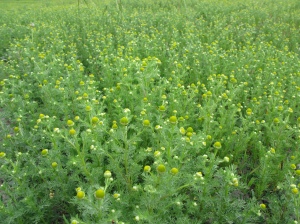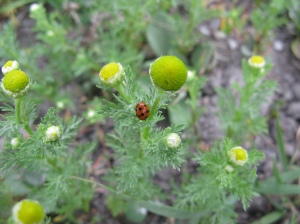You are currently browsing the category archive for the ‘herbs’ category.
Last winter I did a post on how to tell the difference between the various chamomiles, mostly because both nursery chamomile plants and dried chamomile herb are rarely labelled by their botanical name when being sold and I wanted to be able to ID them so I’d know which one I was growing and using. But I also wanted to be able to ID the wild varieties of that family and learn which were medicinal. The most obvious of the wild ones here in NZ is the rayless chamomile, but while I have seen it off and on in the past I’ve not seen it locally and I’ve rarely seen it anywhere in abundance.
Then in December I couldn’t believe my luck when visiting a local organic farm I stumbled upon this beautiful swath of rayless chamomile in flower.
You can read about identifying the different chamomiles in the previous post, but the main keys for the rayless one are:
~ the absence of petals as the flower opens:
~ the finely cut leaves:
~ and the pineapple smell when the plant is crushed (it’s sometimes known as pineapple weed).
That last photo shows a lush and largish plant – most of the ones I’ve seen in the past are smaller than this and it can grow quite low to the ground in a spreading fashion.
I harvested some of the plants (leaves, flowers, stalks) last December, hanging some in bunches to dry and putting some up in vinegar. I’ve made tea a few times and found it interesting, with subtle chamomile flavour. There was a mild relaxing effect but not very strong (I’d like to experiment with a stronger infusion). But it was recent tastings of the vinegar that I had finally decanted that impressed me. The scent is strongly of the plant, and the taste is of the smell – distinctly chamomile with pineapple undertones, so those constituents extract well into vinegar.
I took 1 tablespoon of the vinegar in a glass of water one evening. Within half an hour I was yawning and barely able to keep my eyes open. This effect passed when I got up and moved around so it wasn’t so much sedative as strongly relaxing. I’ve had the same effect several times since. The vinegar is noticeably diuretic for me, so I’m not sure if it would make such a good sleep aid but your mileage may vary. I’d like to try the tea and tincture for the relaxing effect as well and will certainly be experimenting with this plant some more.
Chamomile resources:
It was one of Henriette Kress’ blogposts on using chamomile greens that tipped me off to the medicine of pineapple weed.
Kiva Rose’s plant monograph on chamomile.
The arnica in the garden is in full flower:
This plant was put in from a $5 nursery pot in January. That’s last January. So it flowered in the summer and had all these babies and now it’s flowering again. I’m super impressed because I thought it might be a few years before there were enough flowers to harvest.
Arnica seems to like the dry, very well drained soil, and the warm climate. I’ve tried growing it on the east coast, where it was ok but not prolific. You can sometimes pick up arnica in nurseries, and the seeds and plants are sometimes available on trademe.
I made an infused oil yesterday. I took most of the flowers that were in good condition. I’m hoping that arnica is like calendula in that the more you pick the flowers the more flowers grow.
It’s been a long time since I’ve used arnica oil (it’s hard to find commerically as an oil on its own). Arnica is a classic remedy for strains and bruises. I’ve used homeopathic arnica for this, but would like to try the oil too. Arnica is often avoided for internal use as it is toxic in higher doses, but some herbalists use it in small doses. Here’s US Great Lakes herbalist Jim Macdonald’s view on arnica:
Arnica is among the premier herbs for treating injury. Applied topically, it summons the blood and Vital Force of the body to the injury and will help ease swelling, inflammation, pain, and bruising. Taken internally it helps repair and ease the pain resulting from torn muscles and connective tissues, either from a sprain or from overzealous exercise (think about the achy feeling after a workout, or the first day of heavy duty yardwork in the spring); I’ve taken 5 drops before bed after a hard days labor to ease that sore, achy, “I did too much” feeling that often comes the next morning. Remember, in its herbal form Arnica should be used in small doses of 5-10 drops. Also, because of its action of summoning blood to the site it is applied topically to, it should not be used on broken skin. In such cases, think Yarrow.
I went out today following my nose looking for weeds. My mood is good and I move past the harsh reality that I would have to drive at least an hour to find an intact native ecosystem or even a thriving mixed one. I will take what is on offer – there is comfort to be had from the land that is trying to heal. When I arrive there are 3 kahu hunting rabbits in the paddock. A good sign. One of the kahu is very large, which means it’s an older bird. But the rabbits are big too, I’d like to come back and see the hunt in action.
I wander around and down to the river. It’s all broom and willow and small plants of succession. It’s easy to understand why the river bed is the way it is (flooding limits what can grow here) but harder to make sense of the land up on the banks, rabbit riven, dry, sparse. The paddocks nearby are mown for some reason, but stock have been here too at some stage, which explains why there are so many rabbits (rabbits don’t like long grass) and why only the big trees, inedible shrubs and first sucession plants survive. There is no moving on.
Still it is a beautiful late afternoon and on my way back from the river I come across an oasis. It’s a large double willow. Underneath is a pile of what has been dumped earth and gravel, several metres high and four or five in diameter.. Over the top of this are the lush green plants, especially the annuals that bring advancing fertility each time they die and feed the soil.
I wander around the mound delighted in the abundance of edible and medicinal plants:
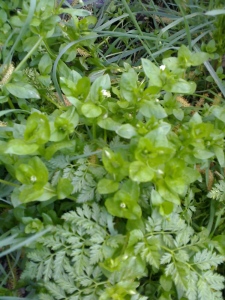
Chickweed – Stellaria media (the brighter green plant) and hemlock – Conium maculatum (the ferny looking one). Eat the chickweed and make medicine from it. Don’t do anything with the hemlock that involves putting it in or on your body, and take special care with look alike edible and medicinal plants from the same family (Umbelliferae) because hemlock is so poisonous. There was enough chickweed here today to eat handfuls while I was looking around. I took some care to make sure my handfuls weren’t mixed with hemlock though.
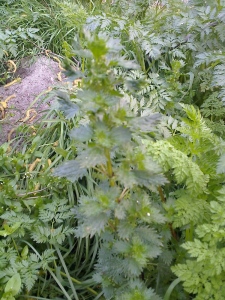
That’s the annual nettle, Urtica urens. A bit tricky to eat because it flowers so early and the leaves aren’t great on nettle once it’s flowering. But it makes fantastic fertiliser, so I am happy to see it in this garden.
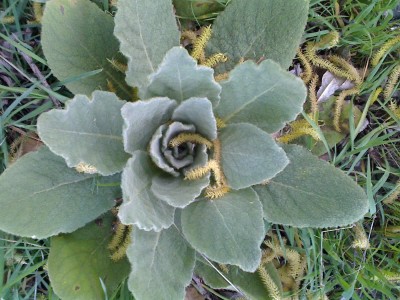
Mullein – Verbascum thapsus. Darling medicine of dry lands, it’s a good general lung healing herb (more on that soon). Seriously not edible – furry and with small hairs that will drive your throat crazy – always strain herbal preparations through a cloth.
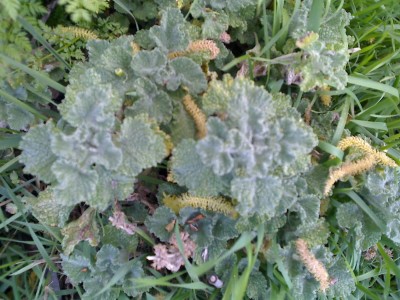
Horehound – Marrubium vulgare. Another medicinal plant, most well known as a cough remedy. Very bitter.
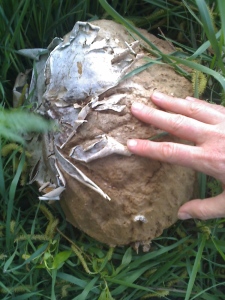
Giant puffball!!! – Calvatia gigantea. I’ve never seen one of these before, they’re apparently a bit rare. It’s past its edibleness, but still a very exciting find. The white bits are the outer cover that has peeled back as the ball had puffed. The brown bit is spongy and sends of clouds out brown spores when you poke it. Even better and more delightful was that once I’d spotted this one, I saw half a dozen others, more decomposed, hiding in the grass:
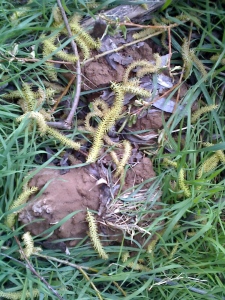
Yep, that is a puffball, collapsing in on itself. They were spread out around half the mound. The puffball bit is the fruit of the fungi. The body of the plant, the mycelium, is underground. I don’t know much about puffballs yet (other than they are edible and the small species is yummy), but mycelium can grow over a much wider area than what you see above ground so I’ve probably been walking on puffball the whole time.
Fungi are the coolest of the cool, very important for ecosystem health especially ones restoring, and they make fantastic people food and medicine. Expect more raving posts about them.
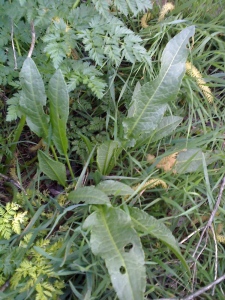
Yellow Dock – Rumex crispus, aka curly dock (you can see the curl especially on the left edge of the leaf in the bottom of the photo). Medicine and food. This is a lovely young succulent looking plant. Possibly even a first year, as I didn’t see any old seed stalks from the autumn. This suggests that the pile of earth has been dumped recently (and this plant came in with that or grew up through).
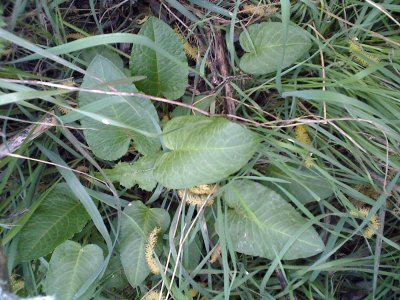
Broad leaf Dock – Rumex obtusifolia (I think). Interchangeable with Yellow Dock, but for some reason I prefer the yellow. Again a young looking plant. The leaves of both docks are tart with oxalic acid. Some people have a higher tolerance for this than others, but if you like it cook it well like spinach. Most edible weed books will have ideas about cooking docks.
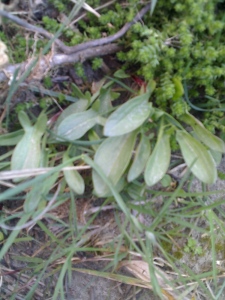
Sheep’s sorrel – Rumex acetosella. Not growing in the garden but nearby. I wanted to include it because it’s related to the docks, and has a delicious sharp lemony taste making it perfect as a garnish or addition to salads. It’s on my to do list to collect seeds for inclusion in a wild greens salad growing mix. Sheep’s sorrel is a small plant, although these ones are a decent size. You can’t tell from the picture but the leaf is maybe an inch and a half long.
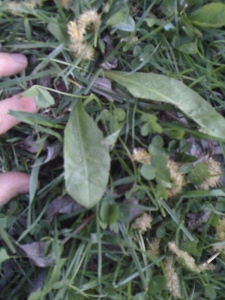
A mystery plant growing out in the mown paddock and on the flat around the willow. I broke the cardinal rule of wildcrafting and grazed on this while wondering what it was (don’t do this at home folks i.e. never eat a plant that you can’t identify). It’s dandelion like, but isn’t dandelion. Possibly chicory, and perhaps it’s been sown in this place in the past. It was bitter but not as much as dandelion, and fresh.
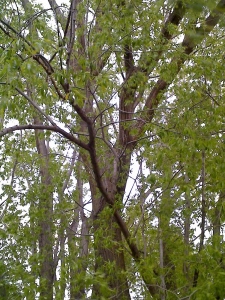
The beautiful tree that made all this possible. We have such a downer on wild willows in this country, but they are incredibly helpful plants. Not only are they medicine trees, but they assist degraded landscapes by keeping the water table high enough for other plants to grow nearby. A friend told me about this recently, and when I looked at this place today it was true that all around the tree, including on the north side, there is more lush growth than away from the tree. The lushness lasts well beyond the shade offered, and past the drip line.
After all that I lay in the grass and watched the sky and crescent moon overhead. It was hard not to think I had been brought here. You can take that literally or poetically, but there is no doubt that the more I open to nature the more it shares with me.

